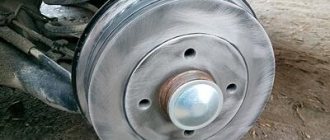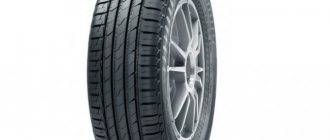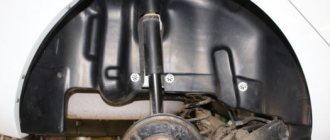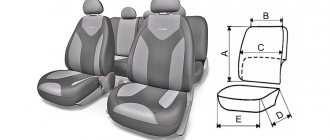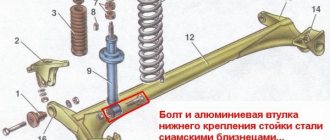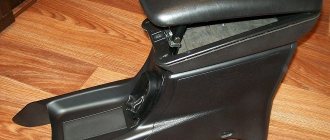Last year, sales of a new domestically produced product began - the LADA Vesta SW CROSS station wagon. Maybe there’s not much that’s domestic left in it, but the car was made here, at our factory! And from the fact that the car turned out to be successful in terms of construction, design and sales, one can only be happy for the new product. A distinctive feature from all previous models produced by AvtoVAZ was the installation of simply huge (by Lada standards) 17-inch wheels. We have already talked about them in one of our articles, and today we will look at the topic of the Lada Vesta SV Cross tire.
Lada Vesta SV Cross tires, as for any other car, are one of the most important elements. Not only handling and braking distance depend on them, but also indicators such as fuel consumption, road stability, acceleration, and overall engine power. In addition, tires affect ride comfort and wear on the suspension in general. That is why it is important to use only tires specified by the manufacturer.
Tire sizes Lada Vesta Cross SV
The table below shows the tire sizes of the Lada Vesta Cross SV.
After analyzing the table, we can conclude that the manufacturer recommends using only one tire size - 205/50 R17 with different load capacity and speed indices.
But what should those who want to install wider or higher tires do?
It is possible to install tires a little wider, for example, in this case, tires with a width of 215 are suitable. You can also use narrower tires, for example, with a width of 195.
| Tires and Wheels Lada Vesta SW Cross | |
| Tires | Discs |
| 195/65R15 | 6.0Jx15 ET37 |
| 205/55R16 | 6.0Jx16ET40 |
| 205/50R17 | 6.5Jx17 ET41 |
| 205/45R18 | 7.0Jx18 ET38 |
| 215/45R17 | 7.0Jx17 ET38 |
| 215/40R18 | 7.0Jx18 ET38 |
To place the tires lower or higher, you will have to play additionally with the diameter of the disc. Everything is done according to the rule: “The higher the tires, the smaller the diameter of the disc, and vice versa.” For example, to install 65 tires on a Lada Vesta SV Cross, you will have to purchase wheels with a diameter of R15. Full tire size information is shown in the table above.
Winter tires on SW Cross
The developers tried to achieve a crossover effect from the standard wheelbase of this car. Winter tires on the Lada Vesta SV Cross can only be installed in 17-inch sizes, since these are the wheels that allow you to achieve a maximum ground clearance of 203 mm. The SV Cross modifications are coming off the assembly lines of automakers, having the following basic characteristics of tires installed in the standard version only for use in the summer:
- If we consider only geometric parameters, then the wheels for this modification of the Lada have the same size - 205/50/R17, which allows the car to have a decent appearance, overcome difficult sections of the road, and also not get stuck on soft ground thanks to the wide sole with powerful treads.
- When choosing winter tires for the Lada Vesta SW Cross, drivers should remember that most of these wheels are produced in an all-season version. If they need to choose a good friction or studded tire, they should still change the wheel to R16, since a 55-60 mm side cord is much more reliable when driving on rough terrain in the cold season.
- When a driver operates his car exclusively in a big city, he may well use all-season tires.
- Vesta Cross tire sizes do not offer drivers a rich assortment due to the specific technical characteristics of the vehicle. Absolutely all tires installed as standard on this modification of Vesta have special indexes.
For example, the XL marking, which means a reinforced side cord, and on such a tire the driver can safely move over sharp rocks, as well as turn at speed, without worrying about the deformation of his tires.
On the profile of the Vesta SV Cross tire you can find the abbreviation M + S, which means Mud and Snow, and translated into Russian - “dirt” and “snow”. This designation does not mean that the tire has excellent grip on the road surface at temperatures below 0 degrees Celsius, but the treads are designed in such a way that the tire has traction properties on almost any surface down to -10 degrees.
You may be interested in this About winter wheels for Renault Duster
Winter tires for Lada Vesta SW Cross
- The last important point when choosing tires for a given car is the shi indices. Considering the model’s ability to overcome areas with poor road quality, as well as the ability to accelerate to a speed of 190 km/h, these parameters in the factory version vary from 89V to 93W. These figures mean that when inflated, each wheel can withstand a load of up to 580-650 kg, and you can safely drive in this state at a speed of 240-270 km/h for at least 30 minutes without the risk of dismantling.
Important!
Despite the fact that AvtoVAZ puts on its premium models only those tires that are produced in the Russian Federation, most world-famous brands often use a size range compatible with Lada. And car enthusiasts can choose a tire to suit every taste and budget.
Test of winter tires from different manufacturers for Lada Vesta SW Cross
Decoding tire sizes Lada Vesta SV Cross
If you read the first part of the material, but did not understand what all these numbers mean, now we will explain everything. For example, we have a tire labeled 195/65 R15 91 T XL. The name and model are not interesting to us, only the parameters themselves.
The first number is the width of the tire in millimeters. In our case - 195 mm.
The second number is usually written separated by a slash and indicates the height of the tire as a percentage of the width. In our case, this is 65% of the width of 195 mm, i.e. approximately 127 mm.
The letter R does not denote radius, as is commonly believed, but simply indicates that the tires have a radial cord. All modern tires for passenger cars are produced using this technology.
The number after R indicates the diameter of the rim in inches for which the tire is designed, or the inner diameter of the tire. In our case, this figure is 15 inches.
The next designation in the rubber marking is the number 91. It indicates the maximum load on one wheel or load index. In our case it is 615 kg. For passenger cars this indicator is not so important, but for trucks it is of great importance. Full information about load indices and their corresponding masses is displayed in the table below:
The letter T in the Lada Vesta Cross tire marking indicates the speed index. In other words, this is the maximum permissible speed at which you can drive a car equipped with such tires. Following the table below, you can easily calculate that you can drive no more than 190 km/h on tires marked T.
And finally, we get to the last indicator. XL - indicates that the tire is reinforced. Those. if XL is indicated next to the marking, then the maximum weight will not be equal to 615 kg, but three units more, i.e. 670 kg.
There are also other designations. For example, the seasonality of tires. Winter tires are always indicated by a snowflake. M+S (M&S, Mud + Snow) - all-season tires. Rain tires are usually indicated by an umbrella pictogram.
These are the basic notations. There are others, for example, the direction of the tread, which allows you to install the wheels correctly on the car and others. But basic symbols will be enough for 80% of drivers.
Tire pressure Lada Vesta Cross
The tire pressure of the Lada Vesta CROSS SV is a very important indicator, since not only the car’s handling and overall driving comfort, but also the safety of the tires and wheels depend on it. The fact is that with high tire pressure it will be very uncomfortable to drive on uneven roads, and this can also lead to premature wear of the tread along the central part of the tire.
Too low tire pressure allows you to drive more comfortably - the ride will be smooth and soft. But at high speeds there is a risk of losing control. In addition, rapid wear of the tire along the edges is possible, and when entering a hole or bump, damage to the tire and disk may occur.
Based on all of the above, we can conclude that the tire pressure on the Lada Vesta Cross should be from 2.1 to 2.5 atmospheres, depending on driving style and usual level of comfort. It is not recommended to overestimate or underestimate the pressure.
How many atmospheres to pump the wheels on the Lada Vesta Cross - instructions
The factory recommendation for Vesta Cross indicates from 2.2 to 2.4 “atmospheres”, this also depends on driving style. The size plays a role, considering that the manufacturer installs R17 wheels and size 205/50. Some people want a higher, wider tire, so they “play” with the inflation level as they want. But, you need to take into account all the features, what the load is, the diameter, the larger the diameter, the smaller the height. It is generally accepted that for the Cross version the average values range from 2.2 to 2.4 atmospheres.
Which tires for the Lada Vesta Cross to choose?
In order to choose tires for the Lada Vesta Cross, you must first decide where the car will be driven and in what conditions. If the car drives around the city on smooth roads, then you can get by with low-profile tires. If the car is used on a primer, then it is better to take higher tires in order to feel all the irregularities less.
The noise level of the tires is also important. For a comfortable ride, you need to choose softer tires. In addition, you need to take into account the tread pattern in order to choose the right tires. At the moment, there are four main types of protectors:
1. Symmetrical directional 2. Symmetrical non-directional 3. Asymmetrical non-directional 4. Asymmetrical directional
Symmetrical directional
This type of tire is excellent for high-speed driving and is also resistant to aquaplaning. The protector does an excellent job of removing water from contact stains. But the downside of such tires is increased noise.
Symmetrical omnidirectional
This is a universal type of tire. It doesn't do a very good job of shedding water from the tires, but it's suitable for leisurely riding for almost any type of driver. But such tires provide a comfortable ride on any type of road - both gravel and highway.
Asymmetrical omnidirectional
The outer part of such tires has a more rigid structure that is resistant to damage. And the inside of the tires is designed for drainage. The central part is responsible for directional stability. However, these tires also have disadvantages - very weak vibration absorption due to the rigidity of the center and outer part.
Asymmetrical directional
This is the rarest option. Not currently produced. These tires were designed to effectively drain water and smoothly distribute the load over the entire surface of the tire. But the difficulty of using it was with the spare wheel, since for a regular car you had to carry 2 of them.
As you can see, there are no ideal tires for the Lada Vesta SV Cross. Each tire has its own disadvantages. Therefore, you need to select tires taking into account your driving style, as well as the weather conditions in which the car will be used.
Technology
At the moment, there are 2 possible options for monitoring tire pressure on Lada Vesta and X-Ray:
- Special sensors;
- Complex ABS.
Special sensors
These elements are installed either directly inside the wheel, or placed outside on the nipple, replacing the caps. A radio channel is used as a means of communication between the sensor and the display, through which data is transmitted.
Complex ABS
In this case, everything is done through the ABS system controllers, since there are no sensors. The peculiarity of this option is that it does not directly read pressure indicators, but instead compares the sum of the angular velocities of rotation of the wheels, after which the difference in indicators is tracked.
The fact is that if the air pressure in the tires drops on the Lada Vesta and X-Ray, the diameter of the wheel becomes slightly smaller, and this leads to the fact that it rotates more often. These changes are monitored by the ABS system controllers, and if there is a difference, the corresponding indicator lights up.
Winter tires for Lada Vesta Cross
In order to choose winter tires for the Lada Vesta Cross, let's go to our favorite website of the Sibir Wheel company. Unfortunately, when searching by car, it is not possible to select the Lada Vesta Cross, so we will search by factory dimensions.
Select width, height and diameter and press search.
As we can see, there is no shortage of summer tires for the Lada Vesta Cross in our city. There were 77 tire options in the price category from 3,250 to 10,400 rubles per wheel. In general, you can choose. I would settle on some average option for 4500-5000 rubles. For example, I really like low-profile Toyo tires. They suit my driving style best and are quite affordable. But, let's return to winter tires. In the search, check the box next to “Winter” and get all the options for winter tires. And this is 48 modifications. There are both friction tires and studded ones. Price range from 3250 to 15,090 rubles per wheel. I prefer studded wheels, so I will choose from them.
For example, the Nokian (Nordman) 7 93T spike model can be purchased for 6,160 rubles per wheel. Judging by the reviews of my friends, these are quite good tires for the money. Don't forget that we choose low-profile winter tires Lada Vesta Cross, so the price can be steep! A set of such tires will cost us 24,640 rubles. Which is quite affordable money these days. Moreover, we will be driving on these tires for many years. If things go well, it will last us 3-4 years. That's all. Thank you for your attention and see you again!
How to choose the right winter tires for Lada Vesta SW Cross
On a note!
Not every tire will have ideal grip properties on slippery surfaces in the winter. If the car enthusiast follows the recommendations below, then he will not have any problems when operating the vehicle:
- If the driver drives his Lada exclusively in the city, then the all-season M + S version with hard treads that will not wear out quickly during sharp braking or when turning on asphalt surfaces will suit him.
- When the vehicle is operated on country roads, or in the region where the driver lives, the air temperature often drops below -10 degrees Celsius, then it is simply impossible to do without full-fledged winter tires. And it’s even better if it is equipped with multi-directional metal spikes, which will ensure the stability of the car during acceleration, braking and cornering.
- If the car is planned to be used on rough terrain with completely snowy roads, then a studded tire will be unnecessary, because the studs play virtually no role in traction, and the main function is taken over by the soft tread. Thus, a car enthusiast should purchase a friction tire, the surface of which is cut into numerous lamellas with sharp edges.
Friction tires on Lada Vesta SW Cross
These elements, when pressed on them under the weight of the car, move apart, forming dozens of cracks, into each of which snow mass falls, lingering there for a certain time.
As the wheel rotates, the traction surface increases significantly, which provides additional frictional force that pushes the car forward without slipping.
If excess moisture forms under the wheels (for example, at zero temperature outside the window, when the snow turns into mush), then it is effectively removed through special grooves for collecting water between the blocks of lamellas.
- When choosing wheels, a car enthusiast can turn not only to companies that are authorized brands of the concern, but also to other brands whose products are adapted for normal use in the middle zone. This means that the chemical composition of the rubber must be selected in such a way that the protectors do not harden even at extremely low temperatures.
You may be interested in Firestone - tire review
It is advisable to select tires that contain admixtures of silicate materials and create an abrasive surface during wear. The most popular brands for Russian car enthusiasts are Nokian, Bridgestone, Pirelli, Michelin, Amtel, Viatti and some other companies that are widespread in the Russian Federation.
Important!
Before choosing a particular tire brand, a car enthusiast needs to verify their authenticity by checking the technical specifications on the tire manufacturer’s website with the data at the retail outlet.
Studded tires for Lada Vesta SW Cross

